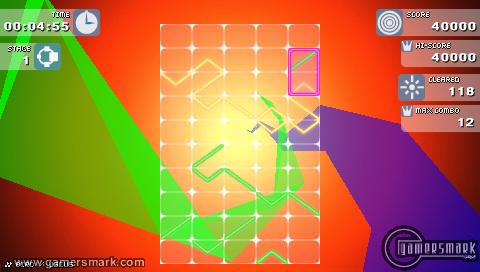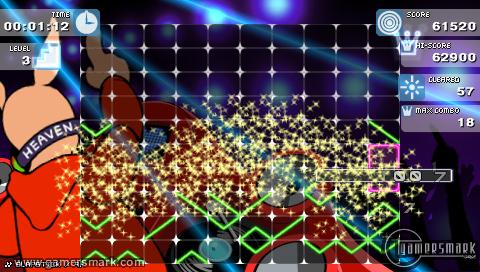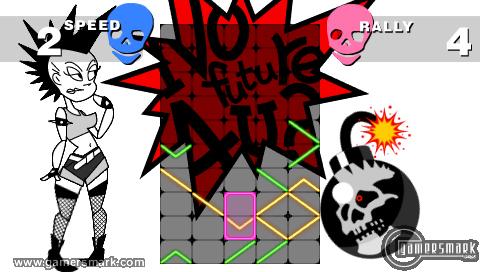Developer: Q Entertainment / Publisher: Buena Vista Games || Overall: 8.5/10
Q Entertainment’s Lumines has become one of the PSP’s staple games. Even as a launch title, the first Lumines still holds up well, even in the wake of its sequel, Lumines II. Lumines II expands upon the great puzzle fun that was to be had with Lumines in the form of new challenges, and a ton of new skins. However, Lumines II delivers a completely different experience from the first Lumines, even though it includes “remixed” versions of songs that were included in the original.
The main distinguishing factor between Lumines and Lumines II is the streamlining of the menu system. Lumines II has a very slick menu system that makes cycling through the various modes offered easy. Not to mention, it is oddly fun in its own right. This time around there’s a lot more to do, and a lot more skins to acquire. In Challenge mode, you are able to take on three different “classes.” Class B, Class A, and Class S all include their own unique skins to play through. In reality, the different classes are actually just shortcuts to a certain point in a full Lumines II lap, as you will be able to play Class S skins if you start in Class B. That is, if you’re good enough to not lose before you get there. In fact, if you’re able to beat each class, a new class will be unlocked that let’s you play through a whole lap including all the skins of Lumines II.
A very important part of the Lumines formula is the music. Lumines fans might be surprised by the music selection in Lumines II because there is quite a bit of licensed popular music, which may or may not be to your fancy. Whether or not you like Fat Boy Slim, Beck, Gwen Stefani, or Missy Elliott, among others, may be a testament to your resolve for how much you like to play the game and unlock new skins through the challenge mode. There are still independent electronic tracks akin to the first Lumines, and a few that are actually very catchy. For most of the licensed tracks, the music video will play in the background as you’re deleting the magical squares. It’s a new level of distraction to see an actual music video playing behind the game, which is quite unlike most of the regular, less noticeable skins. A music video created by Q Entertainment, Genki Rockets’ “Heavenly Star,” is probably the only music video that really proves its worth to be in the game because of how it looks and sounds. Most of the other songs don’t really mend well with the overall electronic soundtrack. When it comes down to it, it really seems like they could have done a better job in the choice of music. For example, I don’t totally loathe Gwen Stefani’s “Hollaback Girl,” but they could have picked something by her that had a little more music to it. A delightful addition to the formula is the Skin Edit Mode, which allows you to build a custom playlist full of the songs you like and leave out the songs you don’t. The only bad thing about this is that it might be a little hard to remember which skin was which, since there is no way to preview skins as you’re selecting them.
All of the modes that were introduced in the first Lumines have been carried over to Lumines II. The modes include VS CPU, Time Attack Mode, and Puzzle Mode. All except Time Attack Mod have been beefed up in terms of content. Time Attack still offers the separate 60/180/300/600 second modes, which allows you to play for a distinct amount of time rather than the variable amount you may play in Challenge mode. VS CPU is no different from what’s found in the first game, which is unfortunate since it would have been nice if they balanced it out a little bit, or reworked the idea completely. Puzzle mode includes all of the puzzles from the first game, so if you blew a vein the first time around, get ready to lose another one since you’ll have to do them all again from the beginning. A new mode, called Mission Mode, gives you specific challenges to complete which are unlike puzzles. Missions usually include having to clear all the blocks in a certain amount of “steps.” Another kind of challenge presented is to fill up the entire game screen with blocks — which will be harder than you think it might be.
An ad hoc multiplayer and data exchange mode (for comparing scores) is included if you have a friend who has a copy of Lumines II. Game sharing allows you to share a demo of Lumines II with a friend. More avatar characters are available to choose from, replay files are able to be saved and loaded, a tutorial mode full of helpful tips, and a free trial of Every Extend Extra are all the different extras that come with Lumines II. A new Song Editor mode allows you to make your own songs with the in-game sequencer. It might be a little hard to get a good song going, but it’s technically possible to make some neat tunes. There are only four slots for custom songs, however. You can load songs from your memory stick, so it is possible to share songs, in some capacity, with others.
Unfortunately Lumines II isn’t the perfect sequel, which is surprising after one looks at how much it falls back on the “more Lumines” forumla. A curious exclusion is the auto-save, which is non-existent as an option. For some reason, Q Entertainment thought it would be better to let us choose when to save everything (which is basically at the end of every game we are playing). Another potential feature that was disappointingly left out is the ability to have individual scoreboards for each skin. It would have been nice to be able to try and beat your best score on a particular skin rather than the oddly non-specific “Skin Edit-Single Lap” score board, since you can add as many skins as you’d like in a single lap, and it doesn’t make any notation to how many skins were used in a “single lap.” A disheartening factor that really made getting into Lumines II feel stale was that there wasn’t much of a “theme song” to get you into the game for the first time. Similar to how “Shinin’” was the theme song for the first Lumines, the only “theme song” I could imagine for Lumines II was “Heavenly Star,” which is placed too far into the game to really meet theme song qualifications.
Even with its faults, Lumines II is a valuable puzzle experience because it offers many different things to do. You will probably get more mileage here when compared to the original, but since the first edition is cheaper it could be hard to recommend Lumines II over it at full price. What both games have going for them is that they deliver separate experiences while fundamentally being the same game, but if it came down to it, Lumines II would be the better long-term purchase due to its sheer amount of skins and content.



